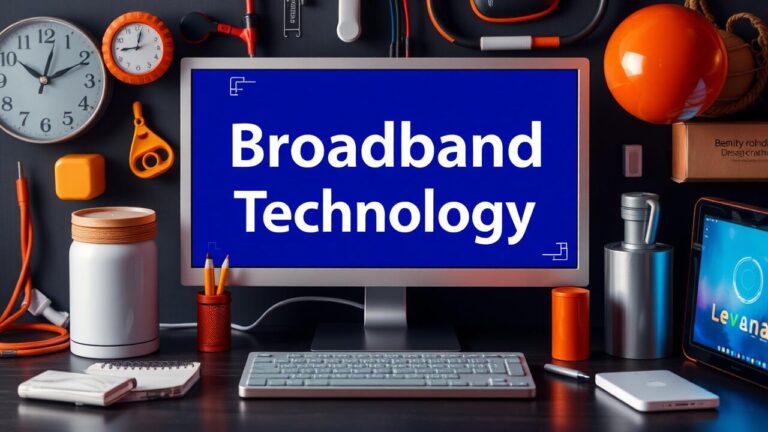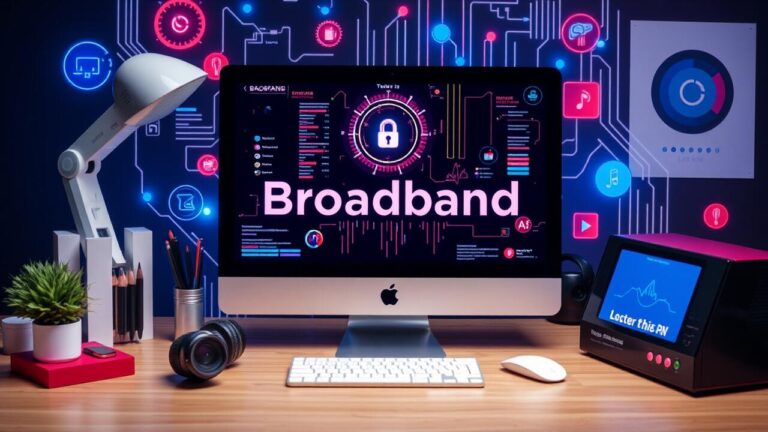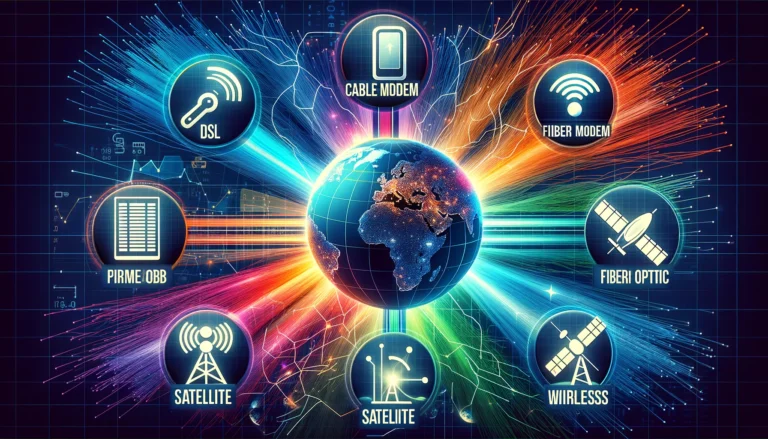Home and Business Broadband
Setting Up a Home Network
Building a solid home network kicks off with the crucial task of picking just the right high-speed internet service provider. It’s not merely about speed; it’s about understanding what your household truly needs. Think streaming marathons, intense gaming sessions, those endless Zoom calls for remote work—these activities demand far more bandwidth than just casual web surfing on a lazy afternoon.
Once you’ve zeroed in on a suitable plan, it’s time to gather all that essential gear: a modem and router that can handle your chosen internet speed like pros. But wait! Don’t forget to ensure that your router’s reach is ample enough to blanket every corner of your abode—no one wants pesky dead zones lurking around.
Now comes the fun part: configuring everything for peak performance and rock-solid security. Dive into the router’s settings and whip up a strong Wi-Fi password—it’s your first line of defense against unwelcome guests sneaking onto your network. And hey, don’t stick with those default admin credentials; shift them around to something unique and memorable! Regularly updating firmware is also key—think of it as giving your system an immune boost against potential cyber threats.
Placement matters too! Positioning the router centrally and at an elevated height will help amplify signal strength throughout every nook and cranny of your space. This meticulous setup lays down a robust groundwork for seamless connectivity across all corners of your home sweet home.
Essential Equipment for Optimal Connectivity
Creating a dependable home network demands several pivotal components to guarantee smooth and uninterrupted connectivity. At the heart of it all lies a modern router—an essential hub that orchestrates the symphony of interconnected devices. Seek out routers boasting the latest Wi-Fi standards, like Wi-Fi 6, which promise not only blistering speeds but also an impressive capacity for juggling multiple connections without breaking a sweat.
But wait! Don’t overlook the magic of mesh networking systems! These ingenious setups can dramatically extend your coverage in larger homes, swooping in to obliterate those pesky dead zones while ensuring every nook and cranny enjoys stellar signal quality.
Now let’s talk about network cables—a seemingly mundane yet crucial element of your arsenal. High-quality Ethernet cables can skyrocket internet speeds for stationary devices such as desktop computers and gaming consoles, transforming your online experience from sluggish to seamless. Choosing cables with robust specifications is vital; after all, no one wants data losses marring their connection reliability!
And if you find yourself grappling with an array of wired devices clamoring for bandwidth? A network switch might just be your knight in shining armor! This nifty gadget ensures that even households bustling with technology have everything they need for peak performance—because when it comes to connectivity, nothing should ever be left wanting!
Security Considerations for Broadband Users
In this whirlwind of the digital era, safeguarding broadband connections emerges as a mission-critical endeavor for individuals and businesses alike. Users must sharpen their awareness of lurking vulnerabilities, taking bold strides to fend off potential risks. Imagine the power of robust passwords—those fortresses for both routers and individual devices—that can dramatically bolster security. And let’s not forget about the vital act of regularly updating firmware; manufacturers are constantly unveiling patches to patch up those sneaky security flaws.
Now, let’s dive deeper: integrating WPA3 encryption can serve as an additional shield against unwelcome intrusions into one’s network—a veritable moat in the realm of connectivity! Yet that’s just scratching the surface—firewalls and antivirus software form another line of defense against a barrage of cyber threats waiting in the wings. Consider this: implementing a Virtual Private Network (VPN) transforms your online presence by cloaking your internet connection in layers of encryption, making it all but invisible to prying eyes.
But here lies an equally crucial piece—the education puzzle! Enlightening every user on your network about phishing schemes and safe browsing habits is paramount; it cultivates a culture steeped in cybersecurity vigilance. By weaving together these strategies, broadband users arm themselves with formidable tools to significantly diminish their chances of succumbing to cyber attacks—all while reveling in the myriad benefits that come with being connected at home or work.
Protecting Your Network from Threats
Securing your network isn’t just a checkbox on a to-do list; it’s an intricate dance of defense against a myriad of lurking threats. First and foremost, don’t overlook the importance of routinely updating router firmware—this is your frontline shield! And while you’re at it, toss out those default passwords like yesterday’s news; instead, craft strong, unique ones that would stump even the most determined intruder.
Now let’s talk remote access: unless you absolutely need it like air in your lungs, disable those features. Why widen the door for potential attackers? They’ll be less likely to creep into your fortress if they can’t find a way in!
But wait—there’s more! A well-configured firewall stands sentinel over your digital realm, scrutinizing every bit of incoming and outgoing traffic as though it were guarding treasure. Layering on encryption protocols like WPA3 for Wi-Fi networks is akin to wrapping everything in impenetrable armor.
And don’t forget about conducting security audits regularly—a crucial practice for sniffing out vulnerabilities hiding in plain sight. With these multifaceted strategies woven together, you’re not merely defending against cyber threats; you’re crafting an unyielding bastion that protects both personal data and essential business information from prying eyes!
| Security Measure | Description | Frequency of Implementation |
|---|---|---|
| Router Firmware Update | Regularly update router firmware to eliminate vulnerabilities. | Every 3-6 months |
| Password Strength | Create strong, unique passwords for all devices and networks. | After any security breach or device change |
| Remote Access | Disable remote access features unless absolutely necessary. | When setting up your network |
| Firewall Configuration | Ensure the firewall is properly configured to monitor all traffic. | Annually or after significant changes to the network |
| Security Audits | Conduct regular security audits to identify and remediate vulnerabilities. | Quarterly |
Comparing Fiber vs. Cable Broadband
Fiber broadband, oh the marvels of fiber-optic technology! It’s like a lightning bolt zipping through the digital ether, offering a plethora of advantages over its traditional cable counterparts. Imagine faster-than-a-cheetah download and upload speeds—perfect for those households drowning in heavy internet usage or juggling remote work demands like circus performers. And let’s not forget about reliability; fiber connections are like the sturdy backbone of your online experience, fending off interruptions and slowdowns even during peak hours when everyone else is clamoring for their slice of bandwidth pie. Plus, they’re less prone to pesky interference from outside forces—think of it as having a shield against chaos, ensuring that your connection remains steady and true.
Now pivoting to cable broadband—it’s still out there, waving its flag with pride! With coaxial cable infrastructure sprawling across urban jungles and suburban landscapes alike, it often plays catch-up with competitive speeds in many locales. Sure, some new technologies can push those numbers impressively high—but beware! During rush hour on the information superhighway, congestion might rear its ugly head, dragging performance down into murky waters. So here we stand at this crossroads: both options have their shiny benefits glimmering in the light. Ultimately though—the decision between fiber and cable broadband rests heavily on personal needs and whimsies intertwined with regional availability and infrastructure nuances lurking beneath the surface.
Benefits and Limitations of Each Type
Fiber broadband boasts a myriad of benefits—think blazing-fast speeds and rock-solid reliability. Imagine the thrill of gigabit speeds coursing through your home, perfectly suited for those high-demand households or businesses swimming in heavy data usage. And let’s not forget: fiber connections stand tall against pesky interference from environmental quirks or network congestion, ensuring that performance remains consistently stellar. This makes fiber an ideal champion for online gaming marathons, seamless streaming sessions, and hefty file transfers.
Yet, on the flip side lies cable broadband—a stalwart choice that’s still widely accessible and often lighter on the wallet. Many users find comfort in its established infrastructure, which paves the way for easier access—especially in areas where fiber hasn’t yet rolled out its shiny promise. But beware! Cable can stumble during peak hours when shared bandwidth turns into a bottleneck, leaving speed to languish just when you need it most. For those who depend on unwavering connectivity for work or binge-watching their favorite shows, this unpredictability can be a real buzzkill during busy times.
- Fiber broadband offers superior speeds, often reaching up to gigabit levels.
- Fiber connections are less susceptible to interference, providing consistent performance.
- Ideal for data-heavy activities such as online gaming, streaming, and large file transfers.
- Cable broadband generally has lower installation and subscription costs.
- Established infrastructure allows for easier access in many areas, particularly where fiber is unavailable.
- Cable broadband can experience slowdowns during peak usage times due to shared bandwidth.
- Users may face connectivity issues with cable during busy hours, affecting their online experience.
The Future of Broadband Technology
The evolution of broadband technology is on the brink of a transformative wave, one that will redefine the connections—both personal and professional—that we hold dear. Picture this: 5G networks and satellite internet are not just buzzwords; they’re catalysts for change, flinging open the doors to high-speed access in those often-neglected rural nooks and crannies. With promises of lightning-fast data rates and impressively low latency, imagine how streaming your favorite shows, diving into immersive gaming worlds, or tackling remote work tasks could become smoother than ever.
And then there’s artificial intelligence creeping in like an ingenious sidekick—ready to tweak network performance with a deft touch! It’s about optimizing every byte of data flowing through these veins while ensuring that traffic management dances seamlessly along its path.
But wait! There’s more—a burgeoning trend towards sustainability is weaving itself into this narrative too. Companies are waking up to their ecological footprints, channeling efforts into energy-efficient infrastructures coupled with renewable energy sources. As our hunger for dependable high-speed internet surges skyward (and let’s be honest—it isn’t slowing down), providers aren’t sitting idle. They’re pouring resources into fiber optic research as if it were liquid gold!
This relentless pursuit of innovation? It signals not just competition but a renaissance in pricing models that promise affordability while enhancing accessibility for users from all walks of life. A future where connection knows no bounds awaits us!
Trends and Innovations on the Horizon
The landscape of broadband technology is in a whirlwind of change, a veritable evolution fueled by lightning-fast advancements in infrastructure and an insatiable hunger for high-speed internet. The much-anticipated rollout of 5G networks isn’t just another upgrade; it’s set to revolutionize connectivity in bustling cities and tranquil rural havens alike. This cutting-edge wireless generation boasts tantalizingly low latency and mind-boggling bandwidth, paving the way for groundbreaking innovations like smart homes that think for themselves, telemedicine that bridges distances with ease, and online experiences so immersive they blur reality.
Meanwhile, satellite internet providers are on a mission—one that aims to stretch the boundaries of bandwidth capabilities into the farthest corners where traditional services have faltered. Imagine high-speed access reaching even those elusive remote areas!
And let’s not forget about emerging technologies like Wi-Fi 6—and oh yes, Wi-Fi 7 is just around the corner—ready to reshape how homes and businesses connect to one another. These advancements promise not only enhanced network efficiency but also an explosion in simultaneous device connections while turbocharging overall performance.
As if that’s not enough, artificial intelligence and machine learning are weaving their magic into network management systems. Picture smarter bandwidth allocation working behind the scenes to elevate user experiences across various applications while optimizing performance as we go along!
With this relentless wave of innovation crashing upon us, users can look forward to broadband solutions that aren’t merely reliable—they’re faster than ever before!
Cost Analysis of Broadband Services
When diving into the world of broadband service selection, grasping the pricing maze is absolutely vital. A myriad of providers lays out an array of plans, each one a unique mix of speed, data limits, and contract durations that can leave you scratching your head in confusion. Sure, those basic packages might lure you in with their lower price tags—but beware! They often come shackled with restrictions that could make your digital life rather cumbersome, especially if you’re juggling multiple devices or are part of a high-data-consuming household. It’s imperative to weigh these considerations carefully as you sift through options; after all, chasing the cheapest plan could very well result in spiraling costs later on—think overage fees or hastily needing to upgrade to something more robust.
And let’s not forget about those sneaky hidden fees lurking around every corner! Installation charges? Check. Equipment rental fees? Absolutely. Early termination penalties? You bet! These little surprises can stack up faster than you’d expect, turning what initially appeared to be a sweet deal into a costly long-term commitment before you even realize it. So take heed: scrutinize the terms and conditions like they’re ancient scrolls awaiting revelation. Digging for details on promotional rates and pinpointing when they vanish into thin air can save you from unforeseen financial headaches down the road. Embracing transparency in pricing is your ticket to making savvy decisions amid this complex landscape!
Understanding Pricing Structures and Hidden Fees
Grasping the intricacies of pricing structures is absolutely crucial when it comes to choosing a broadband service. Providers often dangle those alluringly low starting rates, drawing in unsuspecting consumers with their siren songs. But beware! These enticing introductory prices are typically fleeting, vanishing into thin air after a brief period, leaving customers grappling with escalated monthly charges that can sting. And let’s not even get started on the myriad tiers of service and speed—these variations can drastically skew overall expenses.
Moreover, discerning customers need to keep a sharp eye on the nuances of pricing models; think data caps and throttling policies lurking in the shadows—they wield significant influence over both costs and quality of service.
And then there are those sneaky hidden fees that have caught many off guard: installation charges creeping in, equipment rental fees adding up like unwanted baggage, and early termination penalties looming ominously—all conspiring to bloat your broadband bill beyond what you anticipated. It’s imperative for prospective subscribers to sift through the fine print carefully! The most transparent providers will lay all applicable fees out in plain sight from the get-go. Don’t hesitate—ask for a detailed breakdown of costs! This diligence empowers users to make savvy decisions while fully grasping their financial commitments well beyond just that catchy advertised monthly rate.
Conclusion
Diving into the labyrinth of home and business broadband isn’t just a task; it’s an adventure! The choices are abundant, each more complex than the last. Speed, reliability, costs—these are not mere metrics but pivotal elements that can drastically alter your online journey. As technology hurtles forward at breakneck speed, how we connect to the digital world will inevitably change.
In this swirling vortex of innovation, keeping your finger on the pulse is crucial. New trends emerge like flashes of lightning in a stormy sky; if you blink, you might miss them! And let’s talk about security—crafting robust defenses while juggling budget constraints is no small feat. It’s all about striking that delicate balance to squeeze every ounce of value from your investment while ensuring smooth sailing through cyberspace.
At the end of the day, making well-informed decisions empowers everyone to navigate this vital aspect of contemporary existence with greater ease and confidence. So gear up—an intricate web awaits!






